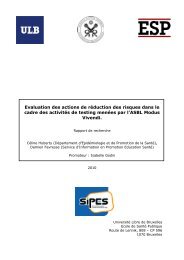Risk assessment of new psychoactive substances - EMCDDA - Europa
Risk assessment of new psychoactive substances - EMCDDA - Europa
Risk assessment of new psychoactive substances - EMCDDA - Europa
- No tags were found...
You also want an ePaper? Increase the reach of your titles
YUMPU automatically turns print PDFs into web optimized ePapers that Google loves.
<strong>Risk</strong> <strong>assessment</strong> <strong>of</strong> <strong>new</strong> <strong>psychoactive</strong> <strong>substances</strong>: operating guidelinesAlso, prevalence <strong>of</strong> use <strong>of</strong> the <strong>new</strong> <strong>psychoactive</strong> substance among specific groupscould be indicative. Such groups may be drug users familiar with the use <strong>of</strong> similar<strong>psychoactive</strong> <strong>substances</strong>, e.g. stimulant users or users <strong>of</strong> opioids.2.3 Potential benefits <strong>of</strong> the substanceIn addition, and where feasible, the beneficial use <strong>of</strong> a <strong>new</strong> substance also needsto be considered to assess the risk-benefit ratio <strong>of</strong> each <strong>new</strong> substance. When <strong>new</strong><strong>psychoactive</strong> <strong>substances</strong> have a therapeutic value, they will in some cases not besubjected to a risk <strong>assessment</strong> since such <strong>substances</strong> may, in line with Article 7.3<strong>of</strong> the Council Decision, be exempted from risk <strong>assessment</strong>. Furthermore, otherfactors such as economic value and industrial use may imply a benefit <strong>of</strong> thesubstance that also needs to be considered.2.4 <strong>Risk</strong>s <strong>of</strong> a substance, independently <strong>of</strong> its legal statusThe scientific risk <strong>assessment</strong> <strong>of</strong> a particular substance should be carried outindependently <strong>of</strong> its legal status in one or more <strong>of</strong> the European Union MemberStates.2.5 Scientific evidence in relation to better-known <strong>substances</strong>Since scientific evidence on <strong>new</strong> <strong>psychoactive</strong> <strong>substances</strong> will, by definition,<strong>of</strong>ten be limited, it will thus be necessary to evaluate the possible risks <strong>of</strong> these<strong>substances</strong> with reference to similar known <strong>substances</strong>. Such comparisonsneed not be restricted to illicit <strong>substances</strong> but may include licit <strong>substances</strong> withsimilar chemical characteristics, pharmacological actions or psychological andbehavioural effects, or which <strong>of</strong>fer relevant insights into the social risks presentedby the substance. Similarly, when assessing the possible consequences <strong>of</strong> controlmeasures, as presented in Chapter 4, it may be appropriate to examine relevantexamples <strong>of</strong> control models involving licit or illicit <strong>substances</strong>.22







